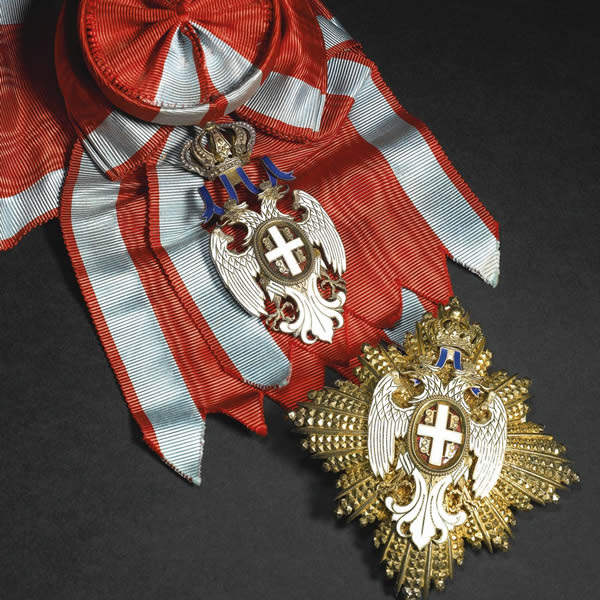Decorations of the Serbian and Yugoslav Monarchy from 1859 until WWII and of the formerly reigning Royal House until present day.
Following the successful 1804-1815 uprisings against the ailing Ottoman Empire, Serbs achieved autonomy as hereditary Principality in 1830 and eventually full independence in 1878.
Their early leaders wore decorations bestowed to them by foreign powers – each with their own interests for awarding them – but it was not until 1859 that the first domestic honors were founded.
The First Medals
Prince Milosh Obrenovich (1780/1783-1860) returned in 1858 from exile amidst political turmoil that ousted his rival Karageorgevich contender from power. Milosh was restored to power by the ‘St. Andrew’s Day Assembly’ of 1858/9 which he subsequently commemorated by establishing Medal “For Loyalty” for his direct supporters (altervatively Cross “For Loyalty” for clergy) and a commemorative Medal of the Event to other deputies.
To commemorate the half-centenary of the 1815 Second anti-Ottoman ‘Takovo’ Uprising led by Milosh, his son and successor Prince Michael III (1823-1868) issued a single-class commemorative Cross of Takovo in 1865. His cousin and successor Prince Milan IV (1854-1901) later expended it into a fully fledged order of merit in five classes and separate civil and military divisions.
Orders of the Kingdom
After the Congress of Berlin granted full independence, Milan elevated the Principality to Kingdom in 1882, changed his regnal name to Milan I, and in the following year founded Orders of the White Eagle and of St. Sava, both in five classes.
Milan’s son and successor Alexander I (1876-1903) founded very lavish single class Order of St. Prince Lazar in 1889, and in 1898 the rarest of all, Order of Milosh the Great in four classes, with only 9 Grand Crosses conferred prior to its abolition only six years later.
Dynastic change
The rival Karageorgevich dynasty reclaimed the throne after Alexander’s assassination in 1903. King Peter I (1844-1921) retained some and abolished other orders founded by the rival Obrenovich dynasty, and in the next year founded the Order of the Star of Karageorge in four classes as the premier order of merit. Ultimately, Peter’s son and heir Alexander I of Yugoslavia (1888-1934) founded the Order of the Yugoslav Crown in five classes, the last monarchical order of merit associated with Serbia.
In exile, to present day
With monarchy abolished after World War II, the exiled King Peter II of Yugoslavia (1923-1970), who never abdicated, retained extant royal orders of merit as part of his royal prerogative. Post-WW2 Yugoslavia abolished royal honors within its jurisdiction, with limited recognition of certain WW1 military awards.
Former King Peter II, despite living in exile in reduced circimstances, never compromised the integrity of his royal honors by bestowing them for benefit or financial gain.
Under construction – Constantly updated – Please visit regularly
